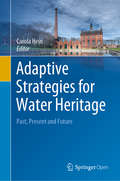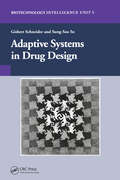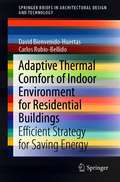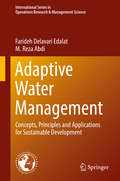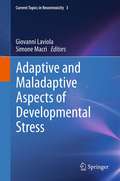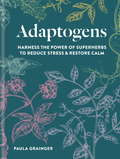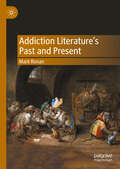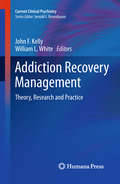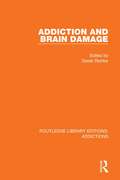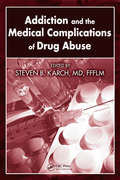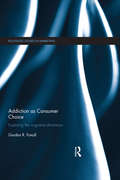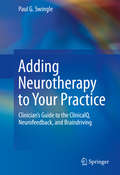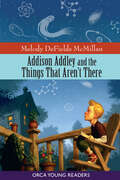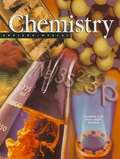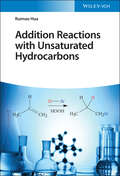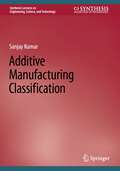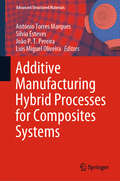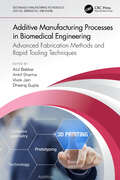- Table View
- List View
Adaptive Strategies for Water Heritage: Past, Present and Future
by Carola HeinThis Open Access book, building on research initiated by scholars from the Leiden-Delft-Erasmus Centre for Global Heritage and Development (CHGD) and ICOMOS Netherlands, presents multidisciplinary research that connects water to heritage. Through twenty-one chapters it explores landscapes, cities, engineering structures and buildings from around the world. It describes how people have actively shaped the course, form and function of water for human settlement and the development of civilizations, establishing socio-economic structures, policies and cultures; a rich world of narratives, laws and practices; and an extensive network of infrastructure, buildings and urban form. The book is organized in five thematic sections that link practices of the past to the design of the present and visions of the future: part I discusses drinking water management; part II addresses water use in agriculture; part III explores water management for land reclamation and defense; part IV examines river and coastal planning; and part V focuses on port cities and waterfront regeneration. Today, the many complex systems of the past are necessarily the basis for new systems that both preserve the past and manage water today: policy makers and designers can work together to recognize and build on the traditional knowledge and skills that old structure embody. This book argues that there is a need for a common agenda and an integrated policy that addresses the preservation, transformation and adaptive reuse of historic water-related structures. Throughout, it imagines how such efforts will help us develop sustainable futures for cities, landscapes and bodies of water.
Adaptive Systems in Drug Design
by Gisbert Schneider Sung-Sau SoA brief history of drug design presented to make clear that there are fashions in this important field and that they change rather rapidly. This is due in part to the fact that the way that a new paradigm is accepted in a drug company often does not depend on its scientific merit alone.
Adaptive Thermal Comfort of Indoor Environment for Residential Buildings: Efficient Strategy for Saving Energy (SpringerBriefs in Architectural Design and Technology)
by Carlos Rubio-Bellido David Bienvenido-HuertasThis book is structured in four parts: First, it analyzes the sustainability objectives established for the building stock and the importance of thermal comfort in this aspect. Second, the existing adaptive thermal comfort models and the main energy-saving measures associated with these models are analyzed. Third, the energy savings obtained with these measures are analyzed in several case studies, comparing the results obtained with other energy conservation measures, such as the improvement of the façade. The analysis is carried out from an energy and economic perspective. Finally, a decision‐making process based on fuzzy logic is established. As an expected result, the content of the book contributes to assist architects in designing more efficient buildings from the perspective of user behavior.
Adaptive Water Management: Concepts, Principles and Applications for Sustainable Development (International Series in Operations Research & Management Science #258)
by Farideh Delavari Edalat M. Reza AbdiThis book explores a new framework of Adaptive Water Management (AWM) for evaluating existing approaches in urban water management. It highlights the need to adopt multidisciplinary strategies in water management while providing an in-depth understanding of institutional interactions amongst different water related sectors. The key characteristics of AWM i. e. polycentric governance, organisational flexibility and public participation are investigated and described through a critical review of the relevant literature. The book presents an empirical case study undertaken in a selected developing-country city to investigate the potential gaps between the current water management approaches and possible implementation of AWM. Feasibility of AWM operations is examined in an environment surrounded by established water management structure with centralised governance and an institutional process based on technical flexibility. The key elements of AWM performance are (re)structured and transformed into decision support systems. Multi criteria decision models are developed to facilitate quantification and visualization of the elements derived from the case study, which is involved with water companies and water consumers. The book describes how the concept of AWM, along with structuring suitable decision support systems, can be developed and applied to developing-country cities. The book highlights the barriers for applying the AWM strategies that include established centralised decision making, bureaucratic interactions with external organisations, lack of organisational flexibility within the institutions, and lack of recognition of public role in water management. The findings outline that despite the lack of adaptability in the current water management in the case study, as an example of developing countries, there are positive attitudes among water professionals and the public towards adaptability through public-institutional participation. /p>
Adaptive and Maladaptive Aspects of Developmental Stress (Current Topics in Neurotoxicity #3)
by Giovanni Laviola Simone MacrìSince the very early stages of life, we all experience some form of stress. Stressors can be mild to severe and can range from unsuccessfully longing for maternal milk in infancy, to recklessly wiggling on a motorbike to be on time to watch the NBA finals on TV, to breaking up a relationship. All those events that we call "stress" have the capability of perturbing a given state of psychological and physiological equilibrium and moving it to a different level. The transition from crawling to walking has to be considered a form of stress as much as losing a job. It is through a continuous cross-talk between environmental stressors and individual adaptations that we build our personalities and our ways to cope with daily hassles. External challenges should not necessarily be regarded as "bad", but instead seen as constructive forces forming our ability to navigate a changing world. What is stress good for? What is stress bad for? When and why do we need to be "stressed"? Should we worry about stress? When does stress equate to "normality"? When does it turn into pathology? We hope with this book to provide some answers to these fundamental questions.
Adaptive and Robust Active Vibration Control: Methodology and Tests (Advances in Industrial Control)
by Ioan Doré Landau Tudor-Bogdan Airimițoaie Abraham Castellanos-Silva Aurelian ConstantinescuThis book approaches the design of active vibration control systems from the perspective of today s ideas of computer control. It formulates the various design problems encountered in the active management of vibration as control problems and searches for the most appropriate tools to solve them. The experimental validation of the solutions proposed on relevant tests benches is also addressed. To promote the widespread acceptance of these techniques, the presentation eliminates unnecessary theoretical developments (which can be found elsewhere) and focuses on algorithms and their use. The solutions proposed cannot be fully understood and creatively exploited without a clear understanding of the basic concepts and methods, so these are considered in depth. The focus is on enhancing motivations, algorithm presentation and experimental evaluation. MATLAB(r)routines, Simulink(r) diagrams and bench-test data are available for download and encourage easy assimilation of the experimental and exemplary material. Three major problems are addressed in the book: active damping to improve the performance of passive absorbers;adaptive feedback attenuation of single and multiple tonal vibrations; andfeedforward and feedback attenuation of broad band vibrations. Adaptive and Robust Active Vibration Control will interest practising engineers and help them to acquire new concepts and techniques with good practical validation. It can be used as the basis for a course for graduate students in mechanical, mechatronics, industrial electronics, aerospace and naval engineering. Readers working in active noise control will also discover techniques with a high degree of cross-over potential for use in their field. "
Adaptogens: Harness the power of superherbs to reduce stress & restore calm
by Paula GraingerIncreasing numbers of people are suffering from stress, anxiety and fatigue caused by lack of sleep, digital overload and our 24/7 lifestyle. In Adaptogens, Medical Herbalist Paula Grainger provides an answer to this modern-day affliction by introducing us to the group of powerful herbal ingredients known as adaptogens..Adaptogens, such as Ashwagandha, Maca, Korean ginseng, Turmeric, Reishi mushrooms, Liquorice, Rosemary and Rhodiola, have been scientifically proven to lower levels of the stress hormone cortisol and prevent adrenal imbalances that can lead to adrenal fatigue and 'burn-out'. Delve into the history and science of these miraculous plants and learn how to maximize wellness using the most easy-to-source adaptogens, incorporating them into your life via delicious smoothies, energy bites and desserts, invigorating teas, tonics and lattes, and wonderful beauty elixirs.
Adaptogens: Harness the power of superherbs to reduce stress & restore calm
by Paula GraingerIncreasing numbers of people are suffering from stress, anxiety and fatigue caused by lack of sleep, digital overload and our 24/7 lifestyle. In Adaptogens, Medical Herbalist Paula Grainger provides an answer to this modern-day affliction by introducing us to the group of powerful herbal ingredients known as adaptogens..Adaptogens, such as Ashwagandha, Maca, Korean ginseng, Turmeric, Reishi mushrooms, Liquorice, Rosemary and Rhodiola, have been scientifically proven to lower levels of the stress hormone cortisol and prevent adrenal imbalances that can lead to adrenal fatigue and 'burn-out'. Delve into the history and science of these miraculous plants and learn how to maximize wellness using the most easy-to-source adaptogens, incorporating them into your life via delicious smoothies, energy bites and desserts, invigorating teas, tonics and lattes, and wonderful beauty elixirs.
Addiction Literature's Past and Present
by Mark RonanAddiction Literature's Past and Present aims to realign consideration of addiction as a transhistorical and transcultural aspect of the human condition. This book illuminates the premodern roots of the linguistic and narrative materials of addiction discourse and argues for Addiction Literature to be considered as a distinct literary phenomenon, with a history stretching back to Antiquity. Addiction, as it is understood in this book, exists at the intersection between appetite, habit and impaired personal behavioural agency. This book begins by exploring the ways in which we articulate the experience (both lived and observed) of addiction today, uncovering a core set of conceptual components and discursive tropes which are commonly associated with modern understandings of the phenomenon. Having established a common set of tropes and features which distinguish modern Addiction Literature as a distinct literary mode, it then considers premodern texts through this lens, revealing similar patterns of conception and convention in a broad range of historical periods and literary genres from Aesop to Shakespeare.
Addiction Recovery Management: Theory, Research and Practice (Current Clinical Psychiatry)
by John F. Kelly William L. WhiteAddiction Recovery Management: Theory, Research, and Practice is the first book on the recovery management approach to addiction treatment and post-treatment support services. Distinctive in combining theory, research, and practice within the same text, this ground-breaking title includes authors who are the major theoreticians, researchers, systems administrators, clinicians and recovery advocates who have developed the model. State-of-the art and the definitive text on the topic, Addiction Recovery Management: Theory, Research, and Practice is mandatory reading for clinicians and all professionals who work with patients in recovery or who are interested in the field.
Addiction and Brain Damage (Routledge Library Editions: Addictions #3)
by Derek RichterOriginally published in 1980, recent research had produced new insights into how, at the biochemical level, alcohol and other drugs of abuse can impair metabolic and neuropsychiatric functions. Epidemiological studies were also demonstrating that even moderate drinking or drug abuse can produce significant brain damage. This book draws together the latest biochemical, physiological and clinical research on these topics at the time. The initial chapters discuss how alcohol can interfere with various functions: the adaptability of metabolic processes as governed by the ability of the liver to synthesise new enzymes, cell membrane transport, nervous transmission and the transport of nutrients into the brain. It is suggested that opiates, and possibly alcohol, may affect the endorphin system by blocking the uptake of specific amino acids. The second half of the book reports clinical investigations using biochemical studies, psychological tests, EEG investigations and Computerised Axial Tomography (CAT) scanning. It gives the first report of a long-term study by Lishman and co-workers using an improved tomography technique to assess brain damage in alcoholics. These studies give convincing evidence that heavy drinking, even at socially-acceptable levels, can cause serious brain damage in vulnerable people.
Addiction and the Medical Complications of Drug Abuse
by Steven B. KarchExtracted from the Drug Abuse Handbook, 2nd edition, to give you just the information you need at an affordable price.Addiction and the Medical Complications of Drug Abuse explores the physiological and psychological phenomenon of addiction including the nature of dependence, the dependence potential of drugs, and the i
Addiction as Consumer Choice: Exploring the Cognitive Dimension (Routledge Studies in Marketing)
by Gordon FoxallA striking characteristic of addictive behavior is the pursuit of immediate reward at the risk of longer-term detrimental outcomes. It is typically accompanied by the expression of a strong desire to cease from or at least control consumption that has such consequences, followed by lapse, further resolution, relapse, and so on. Understood in this way, addiction includes substance abuse as well as behavioral compulsions like excessive gambling or even uncontrollable shopping. Behavioral economics and neurophysiology provide well-worn paths to understanding this behavior and this book regards them as central components of this quest. However, the specific question it seeks to answer is, What part does cognition – the desires we pursue and the beliefs we have about how to accomplish them – play in explaining addictive behavior? The answer is sought in a methodology that indicates why and where cognitive explanation is necessary, the form it should take, and the outcomes of employing it to understand addiction. It applies the Behavioral Perspective Model (BPM) of consumer choice, a tried and tested theory of more routine consumption, ranging from everyday product and brand choice, through credit purchasing and environmental despoliation, to the more extreme aspects of consumption represented by compulsion and addiction. The book will advance debate among behavioral scientists, cognitive psychologists, and other professionals about the nature of economic and social behavior.
Adding Neurotherapy to Your Practice: Clinician’s Guide to the ClinicalQ, Neurofeedback, and Braindriving
by Paul G. SwingleThis clinical manual argues for using neurotherapy to enhance mental health and medical practice across settings and specialties. The text takes readers through the tools and methods of neurotherapy: the ClinicalQ for intake assessment, a stimulated EEG modality called braindriving, and neurofeedback protocols to retrain brain function. Case studies demonstrate neurotherapy as an efficient component in treating brain-related and mind/body conditions and symptoms, from ADHD, sleep disturbances, and depression to fibromyalgia and seizures. Its methods allow clinicians to find deviations in brain function that fall through the diagnostic cracks and choose therapeutic interventions best suited to clients based on reliable data. Included in the coverage: Treating the condition instead of the diagnosis. Case examples illustrating how to conduct the ClinicalQ, interpret results, and convey them to clients. Sample protocols of braindriving and neurofeedback. Using therapeutic harmonics to advance neurotherapy. Age-appropriate neurotherapy for children and seniors. Brainwave diagrams, data tables, client forms, and other helpful tools and visuals. Adding Neurotherapy to Your Practice will interest psychologists, physicians, psychiatrists, chiropractors, and social workers. This stimulating presentation emphasizes the individuality of every client, and the abundant healing capacity of the brain.
Addison Addley and the Things That Aren't There (Orca Young Readers)
by Melody DeFields McMillanAddison Addley hates math. He hates public speaking too. Actually, he hates anything that involves work, but he only has a couple of weeks to write and memorize his grade five speech. The problem is, he can't think of a single topic. When he finally comes up with an excellent idea for a speech, it almost writes itself, but it's his poor math skills that make speech day unforgettable.
Addison-Wesley Chemistry
by James Marshall Arthur N. Applebee Judith A. Langer Sheridan Blau Rebekah Caplan Peter Elbow Susan Hynds Andrea B. BerrnúdezA definitive Chemistry book which covers among others: matter and change, scientific measurement, atomic structure, chemical names and formulas.
Addison-Wesley Chemistry
by Antony C. Wilbraham Dennis D. Staley Michael S. MattaChemistry is the study of the composition of substances and the changes they undergo. The world is complex. Chemistry reflects this complexity in the broad areas it covers. Chemistry contributes to other natural sciences, including biology geology, and physics.
Addison-Wesley Chemistry
by Antony C. Wilbraham Dennis D. Staley Michael S. Matta Edward L. WatermanAddison-Wesley Chemistry is a comprehensive and motivating program that builds problem-solving skills and stresses the relevance and application of chemistry to the present and future life of students.
Addison-Wesley Science
by Addison-Wesley Publishing Company"This book has been made to help you learn science. It has many features to make learning science exciting. It will answer some questions you have and probably start you thinking about some new ones. Explore your book. See what features you can find. To make the most of Addison-Wesley Science, take some time to learn how it is organized. That will make science easier to understand. Find the table of contents. Notice that this book is divided into four units. Each unit focuses on a certain kind of science: life, physical, earth, or health science. Each unit consists of several chapters. Each chapter is made up of a few lessons."
Addition Reactions with Unsaturated Hydrocarbons
by Ruimao HuaAddition Reactions with Unsaturated Hydrocarbons Provides comprehensive coverage of the atom-economic approach to functionalized molecules using unsaturated hydrocarbons as starting materials Unsaturated hydrocarbons have emerged as an important class of fundamental starting materials in organic synthesis. Synthetic methodologies incorporating unsaturated hydrocarbons continue to expand due to their numerous applications in the synthesis of a vast array of chemicals. Addition Reactions with Unsaturated Hydrocarbons presents an up-to-date overview of modern methods that utilize reactions of unsaturated hydrocarbons as building blocks of organic synthesis, covering the conceptual and practical knowledge required for designing atom-efficient reactions to synthesize functionalized molecules. This authoritative volume discusses homo-dimerization and cross-dimerization of alkynes and/or alkenes, synthesis of carbonyl compounds from the hydration of alkynes, cycloadditions of alkynes and alkenes for the synthesis of carbocycles and heterocycles, double functionalization of alkynes and alkenes by addition reactions of element-element bonds, and more. Summarizes the most recent developments in the reactions of unsaturated hydrocarbons Features more than 600 schemes describing typical reactions starting from unsaturated hydrocarbons Covers topics such as alkynylated reactions, addition and cycloaddition reactions of alkynes and alkenes, and carbonylation of alkynes and alkenes with carbon monoxide Includes examples of synthesis procedures of natural products involving alkyne transformation With comprehensive coverage of important reactions of unsaturated hydrocarbons, Addition Reactions with Unsaturated Hydrocarbons is a valuable resource for organic chemists, pharmaceutical chemists, and biochemists in both academia and industry as well as an excellent reference text for graduate students in relevant areas of chemistry.
Additive Fertigung für Chemiewissenschaften und Chemieingenieurwesen
by Seeram Ramakrishna Suresh K. Bhargava Milan Brandt Pr. SelvakannanDieses Buch ist speziell für Forscher sowie Lehrende konzipiert, die einen Fortgeschrittenen-Fertigungs-Kurs in ihren Klassen unterrichten oder einführen. Es präsentiert den aktuellen Forschungsstand in diesem Forschungsbereich und die bisher identifizierten Hauptprobleme für die Integration der additiven Fertigung in chemische Prozesse. Die einzigartige Fähigkeit, Materialien mithilfe aufkommender additiver Fertigungstechnologien in funktionale Bauteile mit spezifischer Geometrie zu verwandeln, hat in Biologie, Ingenieurwissenschaften und Materialwissenschaften erhebliches Interesse geweckt, um maßgeschneiderte Designs für spezifische Anwendungen zu erstellen. Die Anwendungen dieses aufstrebenden Fertigungsverfahren im Bereich der chemischen Wissenschaften und des Ingenieurwesens sind im Anfangssdtadium. Daher liegt der Hauptfokus dieses Buches darauf, die grundlegenden Prinzipien der additiven Fertigungsverfahren sowie den Einsatz in konventionelle chemische Prozesse und verschiedeneVerfahrenstechniken einzuführen. Der potenzielle Vorteil der Anwendung dieser additiven Fertigungstechnologien besteht darin, großtechnisch chemische Prozesse herunterzuskalieren, was mehrere Vorteile bietet, darunter eine geringere Flächenbedarf, Abfallreduktion, effiziente Wärmeintegration und dezentrale chemische Fertigung. Was ist Additive Fertigung? Additive Fertigung (engl.: additive manufacturing, AM) – weitgehend auch als 3D-Druck bezeichnet – ist ein aufstrebendes und innovatives Fertigungsverfahren, das sich grundlegend von konventionellen Herstellungsprozessen unterscheidet und der Forschung und Industrie zu völlig neuen Möglichkeiten verhilft. Bauteile werden Schicht für Schicht aufgebaut und entstehen nicht wie bei herkömmlichen Verfahren durch Abtrag von Material (zum Beispiel durch fräsende Bearbeitung). Dadurch ergibt sich eine enorme Flexibilität und Designfreiheit beispielsweise bei der Herstellung von Prototypen und auch zunehmend in der Serienfertigung. Die Zukunft der additiven Fertigung Die additive Fertigung zählt zu den starken Wachstumsfeldern innerhalb der Produktion. Führende Marktberichte sagen ein durchschnittliches jährliches Wachstum von ca. 20 Prozent für die nächsten fünf Jahre voraus. Das Fraunhofer IGCV geht dabei davon aus, dass dieses Branchenwachstum der additiven Fertigung nicht nur in einem spezifischen Industriezweig zu beobachten sein wird. Vielmehr ist davon auszugehen, dass in allen Industriezweigen der Einsatz additiver Fertigungsverfahren zunehmen wird. Im Jahr 2022 wurden zur Zukunft der additiven Fertigung zwei Studien (An Additive Manufacturing Breakthrough & The Futures of Metal Additive Manufacturing 2030) veröffentlicht, bei denen das Fraunhofer IGCV Zuarbeiten geleistet hat. Die additive Fertigung zählt zu den starken Wachstumsfeldern innerhalb der Produktion. Führende Marktberichte sagen ein durchschnittliches jährliches Wachstum von ca. 20 Prozent für die nächsten fünf Jahre voraus. Das Fraunhofer IGCV geht dabei davon aus, dass dieses Branchenwachstum der additiven Fertigung nicht nur in einem spezifischen Industriezweig zu beobachten sein wird. Vielmehr ist davon auszugehen, dass in allen Industriezweigen der Einsatz additiver Fertigungsverfahren zunehmen wird. Im Jahr 2022 wurden zur Zukunft der additiven Fertigung zwei Studien (An Additive Manufacturing Breakthrough & The Futures of Metal Additive Manufacturing 2030) veröffentlicht, bei denen das Fraunhofer IGCV Zuarbeiten geleistet hat.
Additive Manufacturing Classification (Synthesis Lectures on Engineering, Science, and Technology)
by Sanjay KumarAdditive manufacturing classification is one of the biggest issues faced by AM community. The book provides a comprehensive classification of AM, which can be useful to anyone working in any area of manufacturing. As the classification depends on the interrelation of various AM processes, the book provides concise and critical information of those processes, which can be helpful to anyone looking for a concise book on AM. The book provides original information unavailable in research papers.
Additive Manufacturing Hybrid Processes for Composites Systems (Advanced Structured Materials #129)
by António Torres Marques Sílvia Esteves João P. T. Pereira Luis Miguel OliveiraThis book focuses on the emerging additive manufacturing technology and its applications beyond state-of-the-art, fibre-reinforced thermoplastics. It also discusses the development of a hybrid, integrated process that combines additive and subtractive operations in a single-step platform, allowing CAD-to-Part production with freeform shapes using long or continuous fibre-reinforced thermoplastics. The book covers the entire value chain of this next-generation technology, from part design and materials composition to transformation stages, product evaluation, and end-of-life studies. Moreover, it addresses the following engineering issues: • Design rules for hybrid additive manufacturing; • Thermoplastic compounds for high-temperature and -strength applications; • Advanced extrusion heads and process concepts; • Hybridisation strategies; • Software ecosystems for hAM design, pre-processing, process planning, emulating and multi-axis processing; • 3D path generators for hAM based on a multi-objective optimisation algorithm that matches the recent curved adaptive slicing method with a new transversal scheme; • hAM parameters, real-time monitoring and closed-loop control; • Multiparametric nondestructive testing (NDT) tools customised for FRTP AM parts; • Sustainable manufacturing processes validated by advanced LCA/LCC models.
Additive Manufacturing Processes in Biomedical Engineering: Advanced Fabrication Methods and Rapid Tooling Techniques (Sustainable Manufacturing Technologies)
by Ankit Sharma Vivek Jain Atul Babbar Dheeraj GuptaThis book covers innovative breakthroughs in additive manufacturing processes used for biomedical engineering. More and more, 3D printing is selected over traditional manufacturing processes, especially for complex designs, because of the many advantages such as fewer restrictions, better production cost savings, higher quality control, and accuracy. Current challenges and opportunities regarding material, design, cost savings, and efficiency are covered along with an outline of the most recent fabrication methods used for converting biomaterials into integrated structures that can fit best in anatomy while still obtaining the necessary architecture, mechanical reliability, biocompatibility, and anti-bacterial characteristics needed. Additional chapters will also focus on selected areas of applications such as bionics, affordable prostheses, implants, medical devices, rapid tooling, and drug delivery. Additive Manufacturing Processes in Biomedical Engineering: Advanced Fabrication Methods and Rapid Tooling Techniques acts as a first-hand reference for commercial manufacturing organizations which are mimicking tissue organs by using additive manufacturing techniques. By capturing the current trends of today’s manufacturing practices this book becomes a one-stop resource for manufacturing professionals, engineers in related disciplines, and academic researchers.
Additive Manufacturing Solutions
by Sanjay KumarThis book serves as an accelerated learning tool for students of Additive Manufacturing. The author presents key aspects of the subject in the form of questions and answers, so learners in a variety of contexts can find answers quickly to their specific question. Solutions to a variety of current, challenging problems are presented, clarified with examples, illustrations and copious references for more thorough investigation of the specific topic.Offers a unique, accelerated learning tool for students of Additive Manufacturing, presenting the subject in the form of questions and answers;Provides solutions to today’s challenging problems in additive manufacturing, using examples, illustrations and references;Includes coverage of various aspects of additive manufacturing, such as materials, design, applications, post-process and digital manufacturing.
